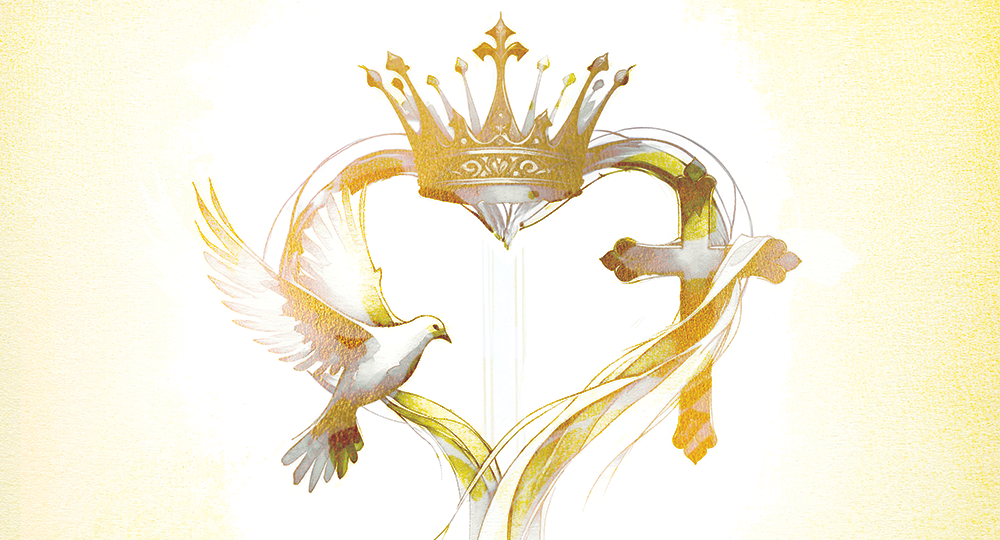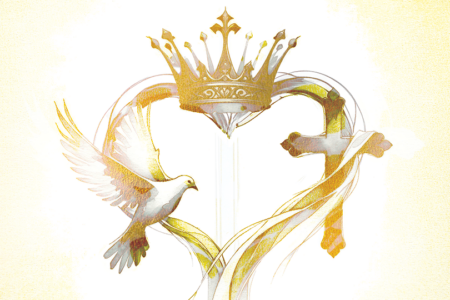Reflections of the Trinity
God’s beautiful design for marriage reflects the perfect relationship between the Father, Son, and Holy Spirit.
In his letter to the Ephesian believers in Christ, the apostle Paul paralleled the marital relationship between a man and a woman with that of Christ and the church (Eph. 5:21–33). This passage sheds light on the structure of the sacred covenant of marriage about which Jesus taught when He quoted Genesis (1:27; 2:24) and declared that a husband and wife are “no longer two but one flesh” (Mt. 19:6).
Paul emphasized the sanctity of marriage when he compared it to Christ’s relationship with His bride, the church. The apostle pictured a relationship far beyond an earthly, mutual agreement between business partners and championed the God-given union of two people—a biological man and a biological woman, each with unique gifts, talents, and skills—becoming one in sacrificial love for each other (Eph. 5:33).
This beautiful mystery of marriage should not surprise us because the Creator of the universe instituted marriage; therefore, it exhibits His character and triune nature. No illustration can fully capture the complexity of the Trinity, but the covenant of marriage gives us reflections of its Designer.
Love
God is love (Jer. 31:3; 1 Jn. 4:8, 16). Love cannot exist in a vacuum; it exists in relation to something else. Without an object of affection, love is more of a wishful desire than an action.
God is also eternal (Gen. 21:33; Ps. 90:2; 1 Tim. 1:17). If the eternal God of the universe were one solitary Person, there would have been a time before creation when He could not have loved actively because there would have been nothing to receive His love. But because God is a Trinity (three Persons in one essence), His love can exist for all eternity in perfect harmony within the Godhead. Love is part of God’s nature.
Unlike the bond of perfect love that exists between the Father, Son, and Holy Spirit, marriage is between a man and a woman who both have sinful natures. For this reason, Paul commanded husbands, “Love your wives, just as Christ also loved the church and gave Himself for her” (Eph. 5:25). And, in his letter to Titus, one of the “good things” Paul instructed older women to teach young women was to “love their husbands” (Ti. 2:4). By striving to love each other in a lifelong commitment as the Bible commands, husbands and wives echo the eternal, perfect, loving relationship found in the Trinity.
Distinction
When a husband and wife join in covenantal love on their wedding day, they marvelously become one in marriage; yet they also retain their unique, God-given, individual identities. When He created humanity, our triune God said, “Let Us make man in Our image, according to Our likeness” (Gen 1:26).
As God’s image-bearers, people can do things that uniquely reflect Him, such as use logic, express creativity, and demonstrate love. The God-given gifts we enjoy as individuals and use to benefit society do not disappear in marriage. Two become one, but each person remains a distinct image-bearer of the Creator.
For example, suppose a doctor and an artist marry. Though the two become one, the doctor does not gain the artist’s ability to paint well; and the artist does not gain the doctor’s ability to administer proper medical care. Each spouse’s unique skills and traits remain his or her own. Marriage is between two people who are one flesh, just as God is three Persons in one essence.
The biblical origin of marriage also helps refute the false doctrine of modalism, which teaches that God is one Person taking on three different roles, or modes, wearing one of three different “masks,” depending on the situation. As two people are joined yet distinct in marriage, God is one essence yet present as three distinct Persons—Father, Son, and Holy Spirit—as revealed at Jesus’ baptism:
When He had been baptized, Jesus came up immediately from the water; and behold, the heavens were opened to Him, and He saw the Spirit of God descending like a dove and alighting upon Him. And suddenly a voice came from heaven, saying, “This is My beloved Son, in whom I am well pleased” (Mt. 3:16–17).
Mutual Submission
Biblical marriage reflects the mutual submission displayed in the Trinity. In both relationships, each person is of equal value but does not have the same role.
When Jesus gave His apostles what is commonly known as the Great Commission, He proclaimed that all authority was given to Him “in heaven and on earth” and told them to baptize believers “in the name of the Father and of the Son and of the Holy Spirit” (28:18–19). Though Jesus had “all authority,” He told His apostles to baptize in the names of all three equal members of the Trinity. Likewise, husbands and wives reflect mutual submission through their distinct marital roles.
In the world’s eyes, distinction quickly leads to comparisons of value. We do it every day: Which car manufacturer is best? Who is the best ballplayer? Is chocolate or vanilla ice cream better? By contrast, God perfectly solves this dilemma in the design of marriage. Two become one yet are distinct as husband and wife, called to serve and love each other selflessly and sacrificially.
There is no better example of sacrificial love than when Jesus, who is fully God, emptied Himself to atone for the sins of humans. Paul exhorted the Philippian believers, “Let this mind be in you which was also in Christ Jesus, who, being in the form of God, did not consider it robbery to be equal with God, but made Himself of no reputation, taking the form of a bondservant, and coming in the likeness of men” (Phil. 2:5–7). If this is the goal in our relationships, how much more should we exhibit selfless love for our spouse in marriage?
Unity
The Shema is a prominent feature of Jewish worship. It originates in Deuteronomy 6:4: “Hear, O Israel: The LORD our God, the LORD is one [Hebrew, echad]!” God’s oneness is evident in how each Person relates to the others: The Son glorifies the Father (Jn. 14:13; Rom. 16:27), the Father glorifies the Son (Jn. 17:1), and the Holy Spirit glorifies the Father and the Son (16:13–15). We do not worship three gods but one God in three Persons.
God’s singularity is reflected through the extraordinary relationship marriage creates. In marriage, two distinct people share the most intimate connection in the human experience. Biological children carry the DNA of both parents, a wonderful picture of two becoming one flesh.
Marriage illustrates how two people can be individuals yet one flesh, just as God is three Persons yet one essence. When a man and a woman join in matrimony, they enjoy the spiritual, physical, and emotional oneness that God designed specifically for the holy bond of marriage. Though imperfect, the relationship between a husband and a wife reflects the unity of the Godhead.
The divine institution of marriage bears the fingerprint of its Designer and reflects the beauty of the Trinity. God, in three Persons, enjoys perfect love for all eternity; and husbands and wives are commanded to love each other. The Father, Son, and Holy Spirit are distinct from one another, have unique roles, and demonstrate perfect submission. In marriage, the husband and wife remain individuals yet are one flesh. God is one essence, and husbands and wives enjoy the pinnacle of human unity.
Marriage, as designed by God, is a treasure; and it helps us better understand and love its Creator.
Photo: Adobe Stock








